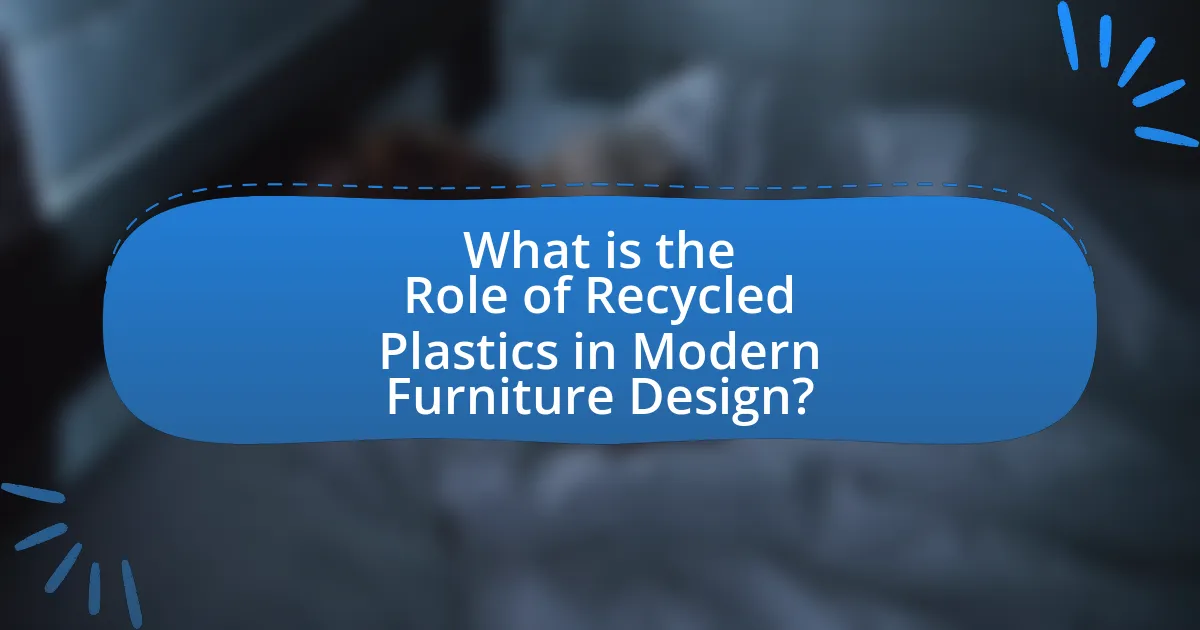Recycled plastics are increasingly integral to modern furniture design, offering sustainable materials that minimize environmental impact and promote resource conservation. The article explores how recycled plastics are processed and integrated into furniture, highlighting their durability and aesthetic potential. It discusses the types of recycled plastics commonly used, the environmental benefits of their incorporation, and the challenges designers face, such as material variability and aesthetic constraints. Additionally, it examines emerging trends, consumer preferences, and successful examples of recycled plastic furniture, emphasizing the importance of sustainability in contemporary design practices.

What is the Role of Recycled Plastics in Modern Furniture Design?
Recycled plastics play a crucial role in modern furniture design by providing sustainable materials that reduce environmental impact. The use of recycled plastics in furniture not only diverts waste from landfills but also conserves natural resources, as it requires less energy to produce than virgin plastic. For instance, a study by the Ellen MacArthur Foundation highlights that using recycled plastics can reduce greenhouse gas emissions by up to 70% compared to traditional plastic production. Additionally, furniture made from recycled plastics often features innovative designs and durability, appealing to eco-conscious consumers. This integration of recycled materials reflects a growing trend towards sustainability in the furniture industry, aligning with consumer demand for environmentally friendly products.
How are recycled plastics integrated into furniture design?
Recycled plastics are integrated into furniture design by transforming waste materials into functional and aesthetic components. Manufacturers process post-consumer plastics, such as bottles and containers, into pellets or sheets, which are then molded or assembled into various furniture pieces. For instance, companies like IKEA and Emeco utilize recycled plastics to create chairs and tables, reducing environmental impact while maintaining durability and style. This approach not only diverts plastic waste from landfills but also promotes sustainability in the furniture industry, as evidenced by the fact that using recycled materials can reduce carbon emissions by up to 70% compared to virgin plastics.
What types of recycled plastics are commonly used in furniture?
Commonly used types of recycled plastics in furniture include polyethylene terephthalate (PET), high-density polyethylene (HDPE), and polypropylene (PP). PET, often sourced from recycled beverage bottles, is favored for its durability and resistance to moisture, making it suitable for outdoor furniture. HDPE, derived from recycled containers and bottles, is known for its strength and weather resistance, ideal for various furniture applications. Polypropylene, which can be recycled from various plastic products, is lightweight and versatile, often used in chairs and tables. These plastics contribute to sustainable furniture design by reducing waste and promoting recycling initiatives.
How does the processing of recycled plastics impact furniture aesthetics?
The processing of recycled plastics significantly impacts furniture aesthetics by enabling diverse design possibilities and enhancing visual appeal. Recycled plastics can be molded into various shapes and textures, allowing designers to create innovative and unique furniture pieces that stand out in the market. For instance, the use of recycled polyethylene terephthalate (rPET) can result in vibrant colors and finishes that mimic traditional materials like wood or metal, thus broadening aesthetic options. Additionally, studies have shown that furniture made from recycled materials can attract environmentally conscious consumers, further influencing design trends and preferences in the industry.
Why is the use of recycled plastics important in furniture design?
The use of recycled plastics is important in furniture design because it significantly reduces environmental impact by minimizing waste and conserving resources. Incorporating recycled plastics into furniture production helps divert plastic waste from landfills and oceans, addressing the global plastic pollution crisis. For instance, using recycled plastics can lower carbon emissions by up to 70% compared to virgin plastic production, as reported by the Ellen MacArthur Foundation. This practice not only promotes sustainability but also encourages a circular economy, where materials are reused and repurposed, ultimately leading to more eco-friendly design solutions.
What environmental benefits does using recycled plastics provide?
Using recycled plastics provides significant environmental benefits, including reduced waste in landfills and decreased demand for virgin plastic production. By recycling plastics, approximately 30% less energy is consumed compared to producing new plastics, which helps lower greenhouse gas emissions. Additionally, recycling plastics conserves natural resources, as it reduces the need for petroleum extraction and processing, which are essential for new plastic production. According to the Environmental Protection Agency, recycling one ton of plastic can save the equivalent of 1,000 to 2,000 gallons of gasoline, highlighting the substantial energy savings associated with recycled plastics.
How does the use of recycled materials influence consumer choices?
The use of recycled materials significantly influences consumer choices by enhancing perceived environmental responsibility and sustainability. Consumers increasingly prefer products made from recycled materials, as studies show that 66% of global consumers are willing to pay more for sustainable brands, according to a Nielsen report. This preference is driven by a growing awareness of environmental issues and a desire to support eco-friendly practices, leading to increased demand for furniture designed with recycled plastics.

What are the challenges associated with using recycled plastics in furniture design?
The challenges associated with using recycled plastics in furniture design include material variability, limited aesthetic appeal, and potential structural weaknesses. Material variability arises because recycled plastics can differ significantly in composition and quality, leading to inconsistencies in performance and durability. Limited aesthetic appeal is often a concern, as recycled plastics may not offer the same visual qualities as virgin materials, which can affect consumer acceptance. Additionally, potential structural weaknesses can occur due to the degradation of plastic during the recycling process, which may compromise the integrity and longevity of the furniture. These challenges necessitate careful consideration and innovation in design and manufacturing processes to effectively utilize recycled plastics in furniture.
What limitations do designers face when working with recycled plastics?
Designers face several limitations when working with recycled plastics, including material variability, aesthetic constraints, and performance issues. The variability in recycled plastics can lead to inconsistent quality, affecting the final product’s durability and appearance. Additionally, the aesthetic options may be limited due to the nature of recycled materials, which can restrict design creativity. Performance issues, such as lower strength and flexibility compared to virgin plastics, can also hinder the functionality of furniture pieces. These challenges are documented in studies highlighting the complexities of integrating recycled materials into design processes, emphasizing the need for innovative solutions to overcome these barriers.
How do the properties of recycled plastics compare to virgin materials?
Recycled plastics generally exhibit lower mechanical properties compared to virgin materials, including reduced tensile strength and impact resistance. Studies indicate that recycled plastics can lose up to 20-30% of their original strength due to degradation during the recycling process. Additionally, recycled plastics may have variations in color and consistency, which can affect aesthetic qualities in furniture design. However, advancements in recycling technology are improving the quality of recycled plastics, making them increasingly viable for applications in modern furniture design.
What are the common misconceptions about recycled plastics in furniture?
Common misconceptions about recycled plastics in furniture include the belief that they are of lower quality and less durable than virgin plastics. In reality, many recycled plastics are engineered to meet or exceed the performance standards of new materials. For instance, products made from recycled high-density polyethylene (HDPE) can be just as strong and weather-resistant as their non-recycled counterparts, making them suitable for both indoor and outdoor use. Additionally, some people think that recycled plastics have a negative environmental impact due to the recycling process; however, studies show that using recycled materials significantly reduces energy consumption and greenhouse gas emissions compared to producing new plastics.
How can designers overcome challenges in using recycled plastics?
Designers can overcome challenges in using recycled plastics by adopting innovative processing techniques and collaborating with material scientists. Innovative techniques, such as advanced extrusion and molding processes, enhance the quality and performance of recycled plastics, making them more suitable for furniture applications. Collaboration with material scientists allows designers to better understand the properties of recycled plastics, leading to improved design strategies that address issues like durability and aesthetic appeal. For instance, research from the University of Cambridge highlights that integrating additives can enhance the mechanical properties of recycled plastics, thereby expanding their usability in furniture design.
What innovative techniques are being developed for recycled plastic furniture?
Innovative techniques being developed for recycled plastic furniture include advanced 3D printing methods, which allow for the precise fabrication of complex designs using recycled plastics. This technique enhances customization and reduces waste by utilizing materials that would otherwise contribute to landfill. Additionally, the use of bio-based additives in recycled plastics improves durability and aesthetic appeal, making the furniture more marketable. Research from the University of Cambridge highlights that integrating recycled plastics with natural fibers can create composite materials that are both lightweight and strong, further expanding design possibilities.
How can collaboration with material scientists enhance furniture design?
Collaboration with material scientists can enhance furniture design by integrating advanced materials and innovative manufacturing techniques that improve durability and sustainability. Material scientists provide expertise in the properties of recycled plastics, enabling designers to create furniture that is not only aesthetically pleasing but also environmentally friendly. For instance, research indicates that using recycled plastics can reduce the carbon footprint of furniture production by up to 70%, as highlighted in a study by the Ellen MacArthur Foundation. This collaboration leads to the development of furniture that meets consumer demands for sustainability while maintaining high performance and design standards.

What trends are emerging in the use of recycled plastics in modern furniture design?
Emerging trends in the use of recycled plastics in modern furniture design include increased sustainability, innovative aesthetics, and enhanced functionality. Designers are prioritizing eco-friendly materials, with recycled plastics being utilized to create visually appealing and durable furniture pieces. For instance, brands like IKEA and Herman Miller are incorporating recycled plastics into their product lines, reflecting a commitment to reducing environmental impact. Additionally, advancements in technology allow for the creation of unique textures and colors from recycled materials, further driving consumer interest. This shift not only addresses environmental concerns but also meets the growing demand for sustainable design in the furniture industry.
How are consumer preferences shaping the future of recycled plastic furniture?
Consumer preferences are significantly shaping the future of recycled plastic furniture by driving demand for sustainable and eco-friendly products. As awareness of environmental issues increases, consumers are prioritizing furniture made from recycled materials, leading manufacturers to innovate and expand their offerings in this category. For instance, a survey by the Furniture Industry Research Association found that 70% of consumers are willing to pay more for furniture made from sustainable materials, indicating a clear market trend towards recycled plastic options. This shift not only influences design choices but also encourages companies to adopt more sustainable practices in their production processes, ultimately transforming the furniture industry towards greater environmental responsibility.
What role does sustainability play in current furniture design trends?
Sustainability is a central focus in current furniture design trends, driving the use of eco-friendly materials and practices. Designers increasingly prioritize sustainable sourcing, opting for recycled plastics and renewable resources to minimize environmental impact. For instance, a report by the Ellen MacArthur Foundation highlights that the furniture industry is shifting towards circular economy principles, which emphasize reusing materials and reducing waste. This trend not only addresses consumer demand for environmentally responsible products but also aligns with global sustainability goals, as evidenced by the growing market for furniture made from recycled materials, projected to reach $10 billion by 2025.
How are brands marketing recycled plastic furniture to consumers?
Brands are marketing recycled plastic furniture to consumers by emphasizing sustainability, durability, and design innovation. They highlight the environmental benefits of using recycled materials, such as reducing plastic waste and lowering carbon footprints. For instance, companies like IKEA and Trex promote their products by showcasing how recycled plastic contributes to a circular economy, appealing to eco-conscious consumers. Additionally, brands often use certifications and eco-labels to validate their sustainability claims, enhancing consumer trust. Marketing campaigns frequently feature testimonials and case studies that illustrate the longevity and aesthetic appeal of recycled plastic furniture, further attracting consumers who value both functionality and style.
What are some successful examples of recycled plastic furniture?
Successful examples of recycled plastic furniture include the “Loll Designs” outdoor furniture line, which utilizes recycled high-density polyethylene (HDPE) sourced from milk jugs and other containers. Another notable example is “Emeco’s 111 Navy Chair,” made from 111 recycled plastic bottles, showcasing durability and design. Additionally, “Trex” produces composite decking and furniture from recycled wood and plastic, emphasizing sustainability. These examples demonstrate the effective use of recycled materials in creating functional and aesthetically pleasing furniture while reducing environmental impact.
Which designers or brands are leading the way in this movement?
Leading the way in the movement of using recycled plastics in modern furniture design are brands such as Herman Miller, Vitra, and Emeco. Herman Miller has incorporated recycled materials into their iconic designs, notably the Recycled Plastic Chair, which utilizes post-consumer plastic waste. Vitra has launched products like the “Plastic Side Chair,” made from 100% recycled polypropylene. Emeco is renowned for its “Navy Chair,” which is crafted from 80% recycled aluminum and has expanded its line to include chairs made from recycled plastics. These brands exemplify innovation and sustainability in furniture design, significantly contributing to the reduction of plastic waste in the industry.
What features make these examples stand out in the market?
The features that make examples of recycled plastics in modern furniture design stand out in the market include sustainability, durability, and innovative aesthetics. Sustainability is highlighted by the use of post-consumer materials, which reduces landfill waste and conserves natural resources. Durability is evidenced by the long lifespan of recycled plastics, which can withstand various environmental conditions without degrading. Innovative aesthetics are showcased through unique designs and color options that appeal to contemporary consumers, as seen in brands like Emeco and their use of recycled materials to create stylish, functional furniture. These features collectively position recycled plastic furniture as a desirable choice in an increasingly eco-conscious market.
What best practices should designers follow when using recycled plastics in furniture design?
Designers should prioritize material sourcing, durability, and aesthetic integration when using recycled plastics in furniture design. Sourcing involves selecting high-quality recycled plastics that meet safety and performance standards, ensuring the materials are suitable for furniture applications. Durability is crucial; designers must assess the mechanical properties of recycled plastics to ensure they can withstand everyday use without compromising structural integrity. Aesthetic integration requires designers to creatively incorporate recycled plastics into their designs, enhancing visual appeal while promoting sustainability. Research indicates that furniture made from recycled materials can reduce environmental impact by up to 70% compared to traditional materials, highlighting the importance of these best practices in achieving both functionality and sustainability.


